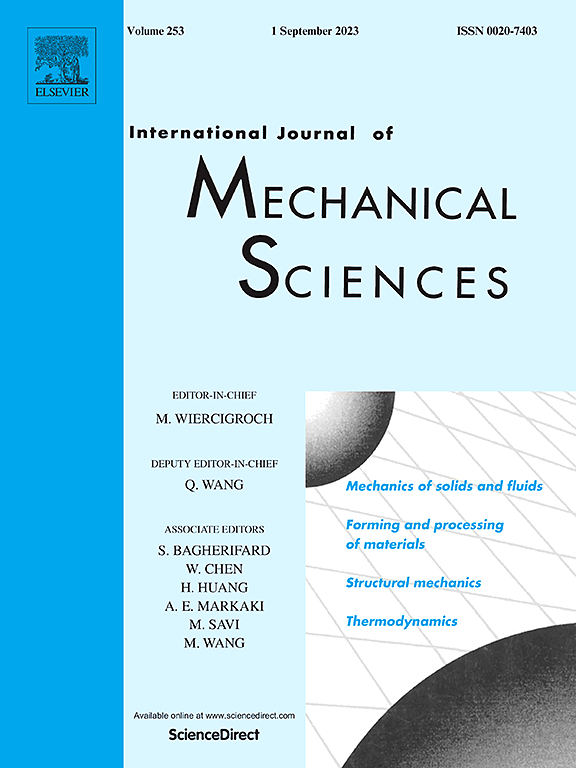磨料射流加工中铣刀刃口珩磨的预测
IF 7.1
1区 工程技术
Q1 ENGINEERING, MECHANICAL
International Journal of Mechanical Sciences
Pub Date : 2025-07-11
DOI:10.1016/j.ijmecsci.2025.110597
引用次数: 0
摘要
刃口珩磨在切削刀具生产中是至关重要的,通过去除微缺陷和创建珩磨刃口轮廓来提高性能。湿磨料射流加工(WAJM)是一种流行的边缘珩磨方法,但由于磨料冲击速度快,变形面积小,很难观察到。本研究提出了一种新的混合模型来预测基于WAJM的刃口珩磨过程,揭示了WAJM参数与铣刀刃口几何形状之间的关系。该模型首先利用计算流体力学(CFD)对颗粒速度和密度的非均匀分布进行建模。基于赫兹接触和动能定理计算了单个磨料撞击平面的材料去除过程,并进一步细化为考虑颗粒表面接触点确定地形表面上的材料去除体积。将CFD仿真结果与解析模型相结合,采用蒙特卡罗方法对动态磨边过程进行了预测。该模型成功地模拟了从锋利的刀尖到相对圆的边缘的过渡,没有预定义的边缘几何形状。铣刀上的WAJM实验表明了良好的模型性能,预测曲线与实测曲线之间的最大欧几里得距离小于1µm。此外,前端面和后端面边缘段的平均预测误差分别为8%和12.3%。研究深入探讨了喷嘴压力和横移速度对刃口几何形状的影响,为刀具生产提供了有价值的指导。本文章由计算机程序翻译,如有差异,请以英文原文为准。

Prediction of milling tool edge honing in abrasive jet machining
Edge honing is crucial in cutting tool production to enhance performance by removing micro defects and creating a honed edge profile. Wet abrasive jet machining (WAJM) is a popular method for edge honing, though challenging to observe due to the high abrasive impact speeds and small deformation areas. This study proposes a novel hybrid model to predict the WAJM-based edge honing process, revealing the relationship between WAJM parameters and the honed edge geometry of milling tools. The model begins from the non-uniform-distribution modeling of particle velocity and density using computational fluid dynamics (CFD). The material removal process for a single abrasive impacting a flat surface is calculated based on Hertz contact and kinetic energy theorem, and further refined to determine the material removal volume on a topographic surface by considering particle-surface contact points. By integrating CFD simulation results with an analytical model, the dynamic edge honing process is predicted using the Monte Carlo method. The model successfully simulates the transition from a sharp tool tip to a relatively rounded edge without predefined edge geometry. WAJM experiments on milling tools indicate excellent model performance, with a maximum Euclidean distance between predicted and measured curves of <1 µm. Additionally, the average prediction errors for edge segments on the rake face and flank face are 8% and 12.3%, respectively. The study thoroughly discusses the effects of nozzle pressure and traverse speed on edge geometry, providing valuable guidance for the cutting tool production.
求助全文
通过发布文献求助,成功后即可免费获取论文全文。
去求助
来源期刊

International Journal of Mechanical Sciences
工程技术-工程:机械
CiteScore
12.80
自引率
17.80%
发文量
769
审稿时长
19 days
期刊介绍:
The International Journal of Mechanical Sciences (IJMS) serves as a global platform for the publication and dissemination of original research that contributes to a deeper scientific understanding of the fundamental disciplines within mechanical, civil, and material engineering.
The primary focus of IJMS is to showcase innovative and ground-breaking work that utilizes analytical and computational modeling techniques, such as Finite Element Method (FEM), Boundary Element Method (BEM), and mesh-free methods, among others. These modeling methods are applied to diverse fields including rigid-body mechanics (e.g., dynamics, vibration, stability), structural mechanics, metal forming, advanced materials (e.g., metals, composites, cellular, smart) behavior and applications, impact mechanics, strain localization, and other nonlinear effects (e.g., large deflections, plasticity, fracture).
Additionally, IJMS covers the realms of fluid mechanics (both external and internal flows), tribology, thermodynamics, and materials processing. These subjects collectively form the core of the journal's content.
In summary, IJMS provides a prestigious platform for researchers to present their original contributions, shedding light on analytical and computational modeling methods in various areas of mechanical engineering, as well as exploring the behavior and application of advanced materials, fluid mechanics, thermodynamics, and materials processing.
 求助内容:
求助内容: 应助结果提醒方式:
应助结果提醒方式:


